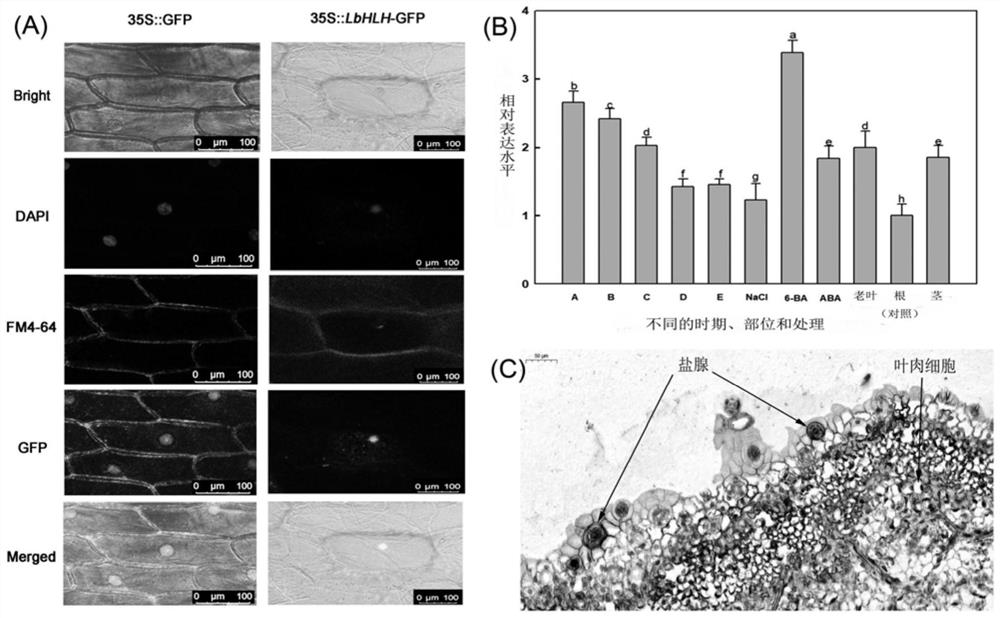Two-color sea lavander herb gene LbHLH and application thereof
A two-color blood-enriching grass, gene technology, applied in application, genetic engineering, plant genetic improvement and other directions, can solve the problems of secondary soil salinization and high cost
- Summary
- Abstract
- Description
- Claims
- Application Information
AI Technical Summary
Problems solved by technology
Method used
Image
Examples
Embodiment 1
[0071] Example 1 Cloning, bioinformatics analysis, subcellular localization and in situ hybridization of LbHLH gene
[0072] 1. Cloning and bioinformatics analysis of LbHLH gene
[0073]Collect a large number of first true leaves at different stages of leaf development, including undifferentiated stage (stage A; 4-5 days after sowing, 5000 leaves), salt gland differentiation stage (stage B; 6-7 days after sowing, 4000 leaves) , stomatal differentiation stage (C stage; 8-10 days after sowing, 3000 leaves), epidermal cell differentiation stage (D stage; 11-16 days after sowing, 1000 leaves), maturity stage (E stage; more than 17 days after sowing, 1000 leaves).
[0074] The total RNA of Limonium bicolor was extracted with a plant total RNA extraction kit (RC401-01; Novizan Biotechnology Co., Ltd.). According to the LbHLH sequence obtained from the reported transcriptome assembly sequence of Limonium bicolor as a reference, Primer 5.0 was used to design primers LbHLH-S and LbHL...
Embodiment 2
[0084] Cloning and Histochemical Analysis of Example 2 Gene LbHLH Promoter
[0085] The total DNA of Limonium bicolor was obtained using the Plant DNA Extraction and Separation Kit (Novizan Biotechnology Co., Ltd.), using the full-length promoter sequence of LbHLH in the genome of Limonium bicolor as a reference, and the extracted Limonium bicolor Using DNA as a template, the full-length promoter sequence of LbHLH was obtained by cloning with primers LbHLH-P-S and LbHLH-P-A (Table 1). The elements in the promoter were predicted by PlantCARE (http: / / bioinformatics.psb.ugent.be / webtools / plantcare / html / ) and CSDS2.0 (http: / / gsds.gao-lab.org / ) A schematic diagram of the components is drawn.
[0086] In order to replace the 35S promoter in pCAMBIA3301 with the LbHLH promoter, the CaMV 35S promoter was excised from pCAMBIA3301 using restriction enzymes HindIII and NcoI to obtain a linear vector, and primers 3301-LbHLH-P-S and 3301-LbHLH- P-A (Table 1) was cloned to obtain the LbHL...
Embodiment 3
[0089] Example 3 Construction of Col-35S::LbHLH transgenic plants
[0090] Use primers LbHLH-OEAt-S and LbHLH-OEAt-A (Table 1) carrying NcoI restriction sites to clone to obtain the full-length CDS of LbHLH, and use restriction enzyme NcoI to single-digest pCAMBIA3301 to obtain a linear vector, and use homologous recombination reagents Cassette (Novazyme Biotechnology Co., Ltd.) ligated the linear vector pCAMBIA3301 and the full-length CDS of LbHLH to generate p35S::LbHLH. The p35S::LbHLH was introduced into Agrobacterium GV3101 to transform Arabidopsis Col-0. After 3 generations of screening with herbicide (Bsata herbicide, the main component is glufosinate-ammonium, 0.1%, v / v), positive transgenic lines were obtained and physiological assays were performed on Col-35S::LbHLH overexpression lines.
[0091] The positive transgenic plants were identified at the molecular level with primers LbHLH-OEAt-S and LbHLH-OEAt-A. Then, mRNA was extracted from different Col-35S::LbHLH tr...
PUM
 Login to View More
Login to View More Abstract
Description
Claims
Application Information
 Login to View More
Login to View More - R&D
- Intellectual Property
- Life Sciences
- Materials
- Tech Scout
- Unparalleled Data Quality
- Higher Quality Content
- 60% Fewer Hallucinations
Browse by: Latest US Patents, China's latest patents, Technical Efficacy Thesaurus, Application Domain, Technology Topic, Popular Technical Reports.
© 2025 PatSnap. All rights reserved.Legal|Privacy policy|Modern Slavery Act Transparency Statement|Sitemap|About US| Contact US: help@patsnap.com



